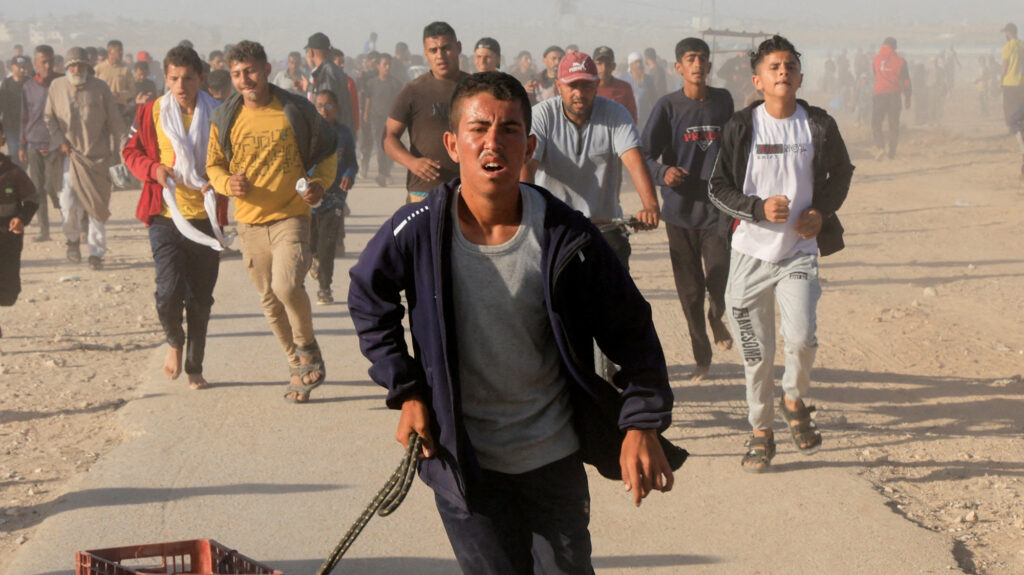At 2am, Ahmad Abu Zubaida received a text message from friends: aid had finally arrived.
Starving under a months-long Israeli siege, he set out for the US and Israeli-backed Gaza Humanitarian Foundation (GHF) distribution point in the central Gaza Strip.
Driven by the urgent need to feed his children and orphaned nephews, Abu Zubaida, a Palestinian father who had recently lost three brothers in Israeli attacks, risked his life to reach the site.
On the way to the centre in the Gaza Valley area, there were no lights and no paved roads.
As he approached the gate, Israeli gunfire erupted.
New MEE newsletter: Jerusalem Dispatch
Sign up to get the latest insights and analysis on
Israel-Palestine, alongside Turkey Unpacked and other MEE newsletters
Dozens around him dropped, some killed, others wounded, many screaming in agony.
“It was as if it were the Day of Judgment,” Abu Zubaida told Middle East Eye, recalling the chaotic scene: shrapnel flying in every direction, the cries of the injured, and the relentless crack of gunfire.
‘I woke up in a hospital bed, my clothes reeking of the decomposing bodies that were beneath me’
– Ahmad Abu Zubaida, Palestinian
In the midst of the chaos, Abu Zubaida fell into a pit more than five metres deep.
“Suddenly, I fell and remembered nothing.”
In pitch darkness, his friends scrambled to find anything that could be used to rescue him. They gathered discarded electrical wires, tied them together, and fashioned makeshift ropes.
One friend climbed down into the pit to secure him. The rescue took nearly two hours, all under constant threat of sniper fire and drone surveillance.
“They pulled me out with electrical cables. After that, I remember nothing… I woke up in a hospital bed, my clothes reeking of the decomposing bodies that were beneath me.”
Abu Zubaida had been transferred to Al-Aqsa Martyrs Hospital in Deir al-Balah, where medical staff were already overwhelmed with casualties from the same aid point.
Burying wounded leg in the sand
In March, Israel imposed a total blockade on the Gaza Strip, plunging two million people into a severe hunger crisis.
By early June, the GHF had opened four aid distribution points, all located in perilous zones surrounded by Israeli forces.
These distribution points replaced the 400 aid points set up across Gaza under the UN, which as well as food, distributed tents and toiletries.
‘Every minute felt like the agony of death, a torment known only to God’
– Mohammed Awidat, Palestinian
Accessible only on foot, the GHF aid points draw thousands of desperate Palestinians each day, many walking long distances in search of food for their children.
For most, it is a journey made out of sheer desperation, a daily risk taken just to survive.
Like Abu Zubaida, 35-year-old Mohammed Awidat felt he had no choice.
A father of five, he was prompted to go after his youngest child, just 18 months old, said her first word: bread.
That night, Awidat set out for one of the US-backed aid points. Despite the crowds and the threat of gunfire, he continued forward.
Soon after, he found himself flat on his back at the bottom of a deep pit, having fallen during the chaos and darkness, just as Abu Zubaida had before him.
Next to him lay a young man with a serious chest injury. To his right, two people had just been killed by Israeli forces.
He felt warmth spreading across his back and realised he was bleeding heavily. Shrapnel from a tank shell had struck his right thigh, nearly severing the leg.
Despite his injuries, Awidat buried his leg in the sand to deter stray dogs, which he feared would be drawn by the blood.
He said he would have preferred to be shot rather than attacked by dogs.
“Every minute felt like the agony of death, a torment known only to God,” he told MEE.
After two hours, civilians nearby heard his cries. The rescue was fraught with difficulty.
With ambulances and civil defence crews barred from the area by Israeli forces, locals had to move him themselves, taking extreme care with the leg, still attached only by skin.
He lost consciousness twice during the four-hour ordeal.
By the time he reached the hospital at dawn, his haemoglobin level had dropped to three due to significant blood loss.
Twenty days later, he still faces the risk of losing the leg, with a long recovery ahead.
Instant death
Since the controversial GHF began limited food distributions in Gaza in late May, Israeli forces have killed at least 600 Palestinians at these aid sites and wounded over 4,000.
Some of the injured, like Abu Zubaida and Awidat, were not hit by bullets, but by falling into deep wells damaged by Israeli bombardments.

‘My journey to get aid in Gaza was like Squid Game’
Read More »
Dr Bara’ al-Attar, a physician in the intensive care unit at Al-Aqsa Martyrs Hospital, described the grim survival odds of such falls.
“Injuries from falls into these wells mostly affect the head and abdomen,” he told MEE.
“Eighty to 90 percent of such cases result in instant death.”
Local media report that at least two aid seekers have died after falling into exposed wells in the Wadi Gaza area.
Dr Ismail Al-Thawabta, director general of the Gaza-based Government Media Office, said a three-stage response plan has been developed to address the risk. The plan involves coordination between municipal authorities and civil defence teams.
However, most of the affected wells are located in high-risk zones that cannot be accessed without prior coordination with Israeli forces.
Without such approval, any rescue or repair efforts face the risk of direct targeting, significantly limiting operations on the ground.


